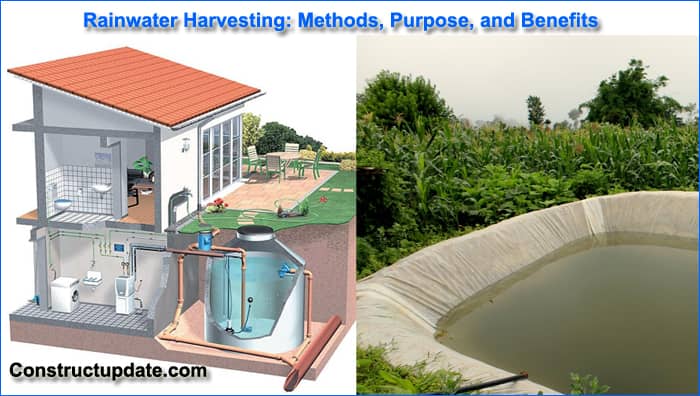Rainwater Harvesting: Purpose, Benefits, Methods, and Applications
Introduction:
Rainwater harvesting is the process of collecting and storing rainwater for later use. It is a sustainable and cost-effective way to conserve water and reduce dependence on municipal water supplies.
Purpose of Rainwater Harvesting:
The main purpose of rainwater harvesting is to conserve water and reduce the demand for municipal water supplies. This is especially important in areas with water scarcity, where rainwater harvesting can provide a reliable source of water for household and agricultural use.
Rainwater Harvesting Methods:
There are several methods of rainwater harvesting, including:
- Roof harvesting: Gathering rainwater from a building’s roof
- Surface harvesting: Collecting rainwater from paved surfaces like driveways and sidewalks
- Ground harvesting: Excavating a hole or trench to catch groundwater during a downpour

Types of Rainwater Harvesting Systems:
There are several types of rainwater harvesting systems, including:
Gravity-fed systems: These methods allow the rainwater to be moved by gravity from the collection area to the storage tank.
Pump-fed systems: With these systems, a pump is used to move the collected rainwater from the collection area to the storage tank.
Integrated systems: These systems are hybrid systems that combine the advantages of pump-fed and gravity-fed systems.
Advantages of Rainwater Harvesting:
Reduced water bills: As it provides a free source of water for domestic usage, rainwater collecting can drastically lower household water expenditures. Water quality is improved since rainwater is pure and free of minerals and salts, making it perfect for domestic usage.
Environmental benefits: By reducing the need for municipal water supply, rainwater collection aids in water conservation and environmental protection.
Increased self-sufficiency: By collecting rainwater, homes become more self-sufficient and rely less on municipal water sources.
Maintenance of Rainwater Harvesting Systems:
A rainwater harvesting system needs to be periodically maintained and cleaned to ensure that it is operating at its best. Cleaning the roof and gutters, routinely inspecting the storage tank for leaks, and cleaning the filters to avoid clogging are a few examples of what falls under this category. Frequent upkeep can help the system last longer and guarantee that the water being stored is of high quality.
Costs of Rainwater Harvesting Systems:
The cost of a rainwater harvesting system can vary depending on the size of the system and the type of system chosen. Smaller, gravity-fed systems can be relatively inexpensive, while larger, pump-fed systems can be more expensive. However, the long-term cost savings from reduced water bills and increased self-sufficiency can make rainwater harvesting a cost-effective investment.
Applications of Rainwater Harvesting:
Rainwater harvesting has a wide range of applications, including:
Household use: You can use rainwater for domestic tasks like washing clothes, flushing the toilet, and watering plants.
Agricultural use: Rainwater can be utilised to water cattle and irrigate crops.
Industrial use: Rainwater is used for cooling towers and fire suppression systems in industry.
Environmental Considerations:
Rainwater harvesting can have positive environmental impacts, such as reducing the demand for municipal water supplies and conserving water. However, it is important to consider the potential negative impacts of rainwater harvesting, such as the increased risk of water-borne diseases if the water is not properly treated, and increased pressure on groundwater resources in areas with high rainfall.
In conclusion, rainwater harvesting is a sustainable and cost-effective way to conserve water and reduce dependence on municipal water supplies. By regularly maintaining and cleaning the system, households, and communities can ensure that the water stored is of good quality. With a wide range of applications, rainwater harvesting can provide a reliable source of water for the household, agricultural, and industrial use.





